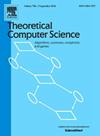论某些数学对象的递归平铺
IF 0.9
4区 计算机科学
Q3 COMPUTER SCIENCE, THEORY & METHODS
引用次数: 0
摘要
这篇文章以一种新颖的方式,利用多米诺骨牌、方形瓦片、连锁瓦片和流动瓦片等各种瓦片,将递归定义的、可能无限的数学对象(如二进制代码表和空间填充希尔伯特曲线的变体)可视化为近似值。通过将这些瓦片对象定义为 L 系统,我们可以看到 L 系统的威力。本文章由计算机程序翻译,如有差异,请以英文原文为准。
On recursive tiling of some mathematical objects
This essay, in a novel way, uses various tiles, such as dominoes, square-, interlocking-, and flow-tiles, to visualize approximations to recursively defined, potentially infinite mathematical objects, such as binary code tables, and variants of the space-filling Hilbert curve. The power of L-systems is shown by defining these tiled objects as L-systems.
求助全文
通过发布文献求助,成功后即可免费获取论文全文。
去求助
来源期刊

Theoretical Computer Science
工程技术-计算机:理论方法
CiteScore
2.60
自引率
18.20%
发文量
471
审稿时长
12.6 months
期刊介绍:
Theoretical Computer Science is mathematical and abstract in spirit, but it derives its motivation from practical and everyday computation. Its aim is to understand the nature of computation and, as a consequence of this understanding, provide more efficient methodologies. All papers introducing or studying mathematical, logic and formal concepts and methods are welcome, provided that their motivation is clearly drawn from the field of computing.
 求助内容:
求助内容: 应助结果提醒方式:
应助结果提醒方式:


